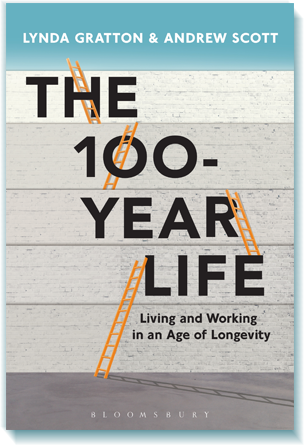 By Mark Venning, ChangeRangers.com
By Mark Venning, ChangeRangers.com
Special to the Financial Independence Hub
If you accept the global average life expectancy as tabled by the World Health Organization (WHO), which currently rests at 71.4 (all factors calculated), it’s hard to imagine taking any projections fourteen years out to 2030 up to age 80, let alone 100.
There is no denying that the number of centenarians has increased in certain parts of the world, and I’m sure there’s a spot in a Blue Zone I can sell you on moving to, if you can’t begin one in your own back yard.
Canada, at an average life expectancy of 82.2, may not be a designated Blue Zone, but if you like the WHO’s info graphics colours, I’ll take Canada’s dark green – a lush, promising shade for an age of longevity. How fortuitous then, in the green of early July, that I should happen to be reading The 100-Year Life by Lynda Gratton & Andrew Scott, another volume written in the re-think aging category of a contemporary western world.
100-year life
By the acknowledgement of the authors, this concept of The 100-Year Life will not be an achievable reality for everyone within the next foreseeable stretch of years to 2030. To quote – “One of the audiences for whom this book was written are those who benefit from high levels of education and income and possess some market power in the workplace with their employer and an array of choices and options.”
Re-creation in escalating transitions over a longer lifespan
Flush with the choices and options of living in a dark green society like Canada, I wonder for example, how many people who fall within this audience are actually in the frame of mind to accept the notion of “re-creation” to the degree put forth here in this book? The main premise of the book is based on the notion that if we are to live a longer one hundred year life, the old three stage model of life; education, employment, retirement is no longer viable.
The process of an escalating series of transitions over a longer lifespan, changes the narrative of a life course; which, without getting technical, are two different life word themes. And not to digress too wildly, this is like arguing for a newer, more relevant meaning for the word career, which also is used in this book. Since the mid-90’s, throughout my time in the career development field, I’ve progressively leaned to the definition of career as being your life’s journey.
This leads back to how we face the potential of a one hundred year life. Looking out from the early years of this century, our life course or career/life journey will continue to be influenced greatly by so many other world developments at a macro level that the re-creation abilities required for all generations through multiple transitions will not simply be seen as a skill set, but an asset, as Gratton & Scott aptly state.
As I have reflected often, expect this process as a constant, in a life that is more itchy and episodic in nature. Even in an 80-year life scenario, some people are grasping at answers for re-creation, reinvention or – redirection (as my colleague Suzanne Cook calls it), at a later life of 50 plus. In Canada, if you are at the short end of that number, you still could have 32.2 years of re-creation process, which is of course quite distinct from a lifestyle pursuit for recreation.
Defining yourself as “asset-rich”
If you are, at any age and stage, in need of a little re-creation, the 4th chapter of The 100 Year Life asks us to re-frame our pitch for living and working longer, not by the old terms of reference that litter resumes and yes, even LinkedIn profiles, but in terms of being a person who has holistic assets. These fall under three categories here: productive, vitality and transformational assets – and the book articulates these very well.
In 1994, William Bridges lit a spark for this in his discussion of personal assets in his book, Job Shift, when he talked about knowing your own D.A.T.A. (desires, abilities, temperament and assets). As Bridges said, your assets don’t need to be literal, and as Gratton takes further, they can be deemed as intangible but not independent from those tangible, linear ones. Now, we move from career management in a post Job Shift era, to asset management in The 100-Year Life.
As I suggested to career service professionals in my July 12 blog post; it’s time to realize that you can no longer be safe with the career philosophies you project on to your clients. Strategies must be more nimble for a future where time is in want of deeper, more provocative career or, shall we say, life course conversations.
All of this begs for a new language that not only speaks easily to the “asset-rich” audience “with market power” as targeted in this book, but also to those “with low assets” who need help in what must therefore seem like an even longer, more challenging 100 Year Life.
 Mark Venning works with non-profit and business leaders, providing presentations, research and advisory services on the Business & Social Aspects of Aging Demographics – and 1:1 with business professionals “leaving the corporate crow’s nest” to explore Entrepreneurship in Later Life. www.changerangers.com
Mark Venning works with non-profit and business leaders, providing presentations, research and advisory services on the Business & Social Aspects of Aging Demographics – and 1:1 with business professionals “leaving the corporate crow’s nest” to explore Entrepreneurship in Later Life. www.changerangers.com


